Views and History of Aboriginals and Torres Strait Islander People
VerifiedAdded on 2023/06/08
|6
|1286
|143
AI Summary
This article explores the personal views and history of Aboriginals and Torres Strait Islander People, their culture, social structures, health, and education. It discusses the challenges they face in accessing healthcare and education due to their remote location and cultural barriers. The article also highlights the importance of their land in sustaining their culture and spiritual wellbeing.
Contribute Materials
Your contribution can guide someone’s learning journey. Share your
documents today.
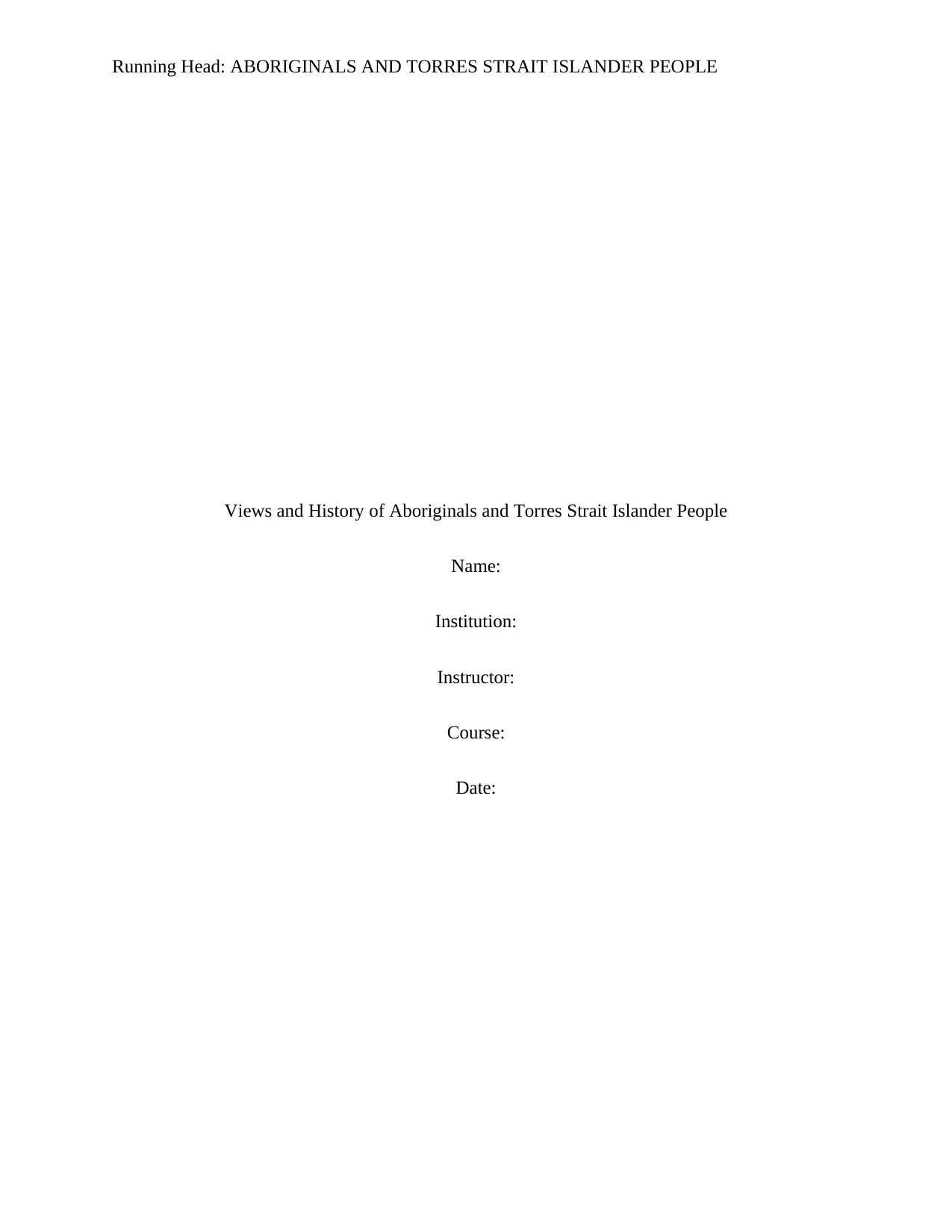
Running Head: ABORIGINALS AND TORRES STRAIT ISLANDER PEOPLE
Views and History of Aboriginals and Torres Strait Islander People
Name:
Institution:
Instructor:
Course:
Date:
Views and History of Aboriginals and Torres Strait Islander People
Name:
Institution:
Instructor:
Course:
Date:
Secure Best Marks with AI Grader
Need help grading? Try our AI Grader for instant feedback on your assignments.
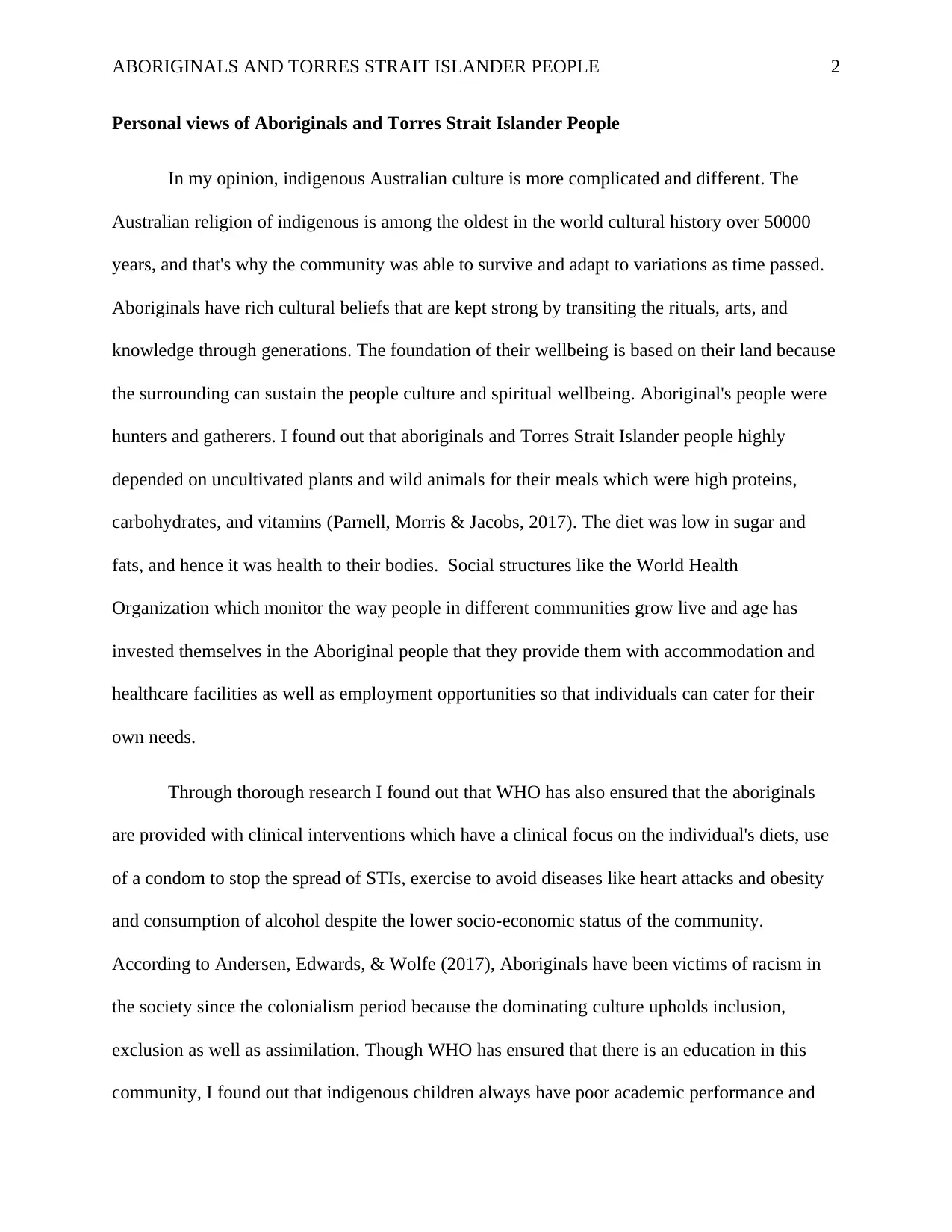
ABORIGINALS AND TORRES STRAIT ISLANDER PEOPLE 2
Personal views of Aboriginals and Torres Strait Islander People
In my opinion, indigenous Australian culture is more complicated and different. The
Australian religion of indigenous is among the oldest in the world cultural history over 50000
years, and that's why the community was able to survive and adapt to variations as time passed.
Aboriginals have rich cultural beliefs that are kept strong by transiting the rituals, arts, and
knowledge through generations. The foundation of their wellbeing is based on their land because
the surrounding can sustain the people culture and spiritual wellbeing. Aboriginal's people were
hunters and gatherers. I found out that aboriginals and Torres Strait Islander people highly
depended on uncultivated plants and wild animals for their meals which were high proteins,
carbohydrates, and vitamins (Parnell, Morris & Jacobs, 2017). The diet was low in sugar and
fats, and hence it was health to their bodies. Social structures like the World Health
Organization which monitor the way people in different communities grow live and age has
invested themselves in the Aboriginal people that they provide them with accommodation and
healthcare facilities as well as employment opportunities so that individuals can cater for their
own needs.
Through thorough research I found out that WHO has also ensured that the aboriginals
are provided with clinical interventions which have a clinical focus on the individual's diets, use
of a condom to stop the spread of STIs, exercise to avoid diseases like heart attacks and obesity
and consumption of alcohol despite the lower socio-economic status of the community.
According to Andersen, Edwards, & Wolfe (2017), Aboriginals have been victims of racism in
the society since the colonialism period because the dominating culture upholds inclusion,
exclusion as well as assimilation. Though WHO has ensured that there is an education in this
community, I found out that indigenous children always have poor academic performance and
Personal views of Aboriginals and Torres Strait Islander People
In my opinion, indigenous Australian culture is more complicated and different. The
Australian religion of indigenous is among the oldest in the world cultural history over 50000
years, and that's why the community was able to survive and adapt to variations as time passed.
Aboriginals have rich cultural beliefs that are kept strong by transiting the rituals, arts, and
knowledge through generations. The foundation of their wellbeing is based on their land because
the surrounding can sustain the people culture and spiritual wellbeing. Aboriginal's people were
hunters and gatherers. I found out that aboriginals and Torres Strait Islander people highly
depended on uncultivated plants and wild animals for their meals which were high proteins,
carbohydrates, and vitamins (Parnell, Morris & Jacobs, 2017). The diet was low in sugar and
fats, and hence it was health to their bodies. Social structures like the World Health
Organization which monitor the way people in different communities grow live and age has
invested themselves in the Aboriginal people that they provide them with accommodation and
healthcare facilities as well as employment opportunities so that individuals can cater for their
own needs.
Through thorough research I found out that WHO has also ensured that the aboriginals
are provided with clinical interventions which have a clinical focus on the individual's diets, use
of a condom to stop the spread of STIs, exercise to avoid diseases like heart attacks and obesity
and consumption of alcohol despite the lower socio-economic status of the community.
According to Andersen, Edwards, & Wolfe (2017), Aboriginals have been victims of racism in
the society since the colonialism period because the dominating culture upholds inclusion,
exclusion as well as assimilation. Though WHO has ensured that there is an education in this
community, I found out that indigenous children always have poor academic performance and
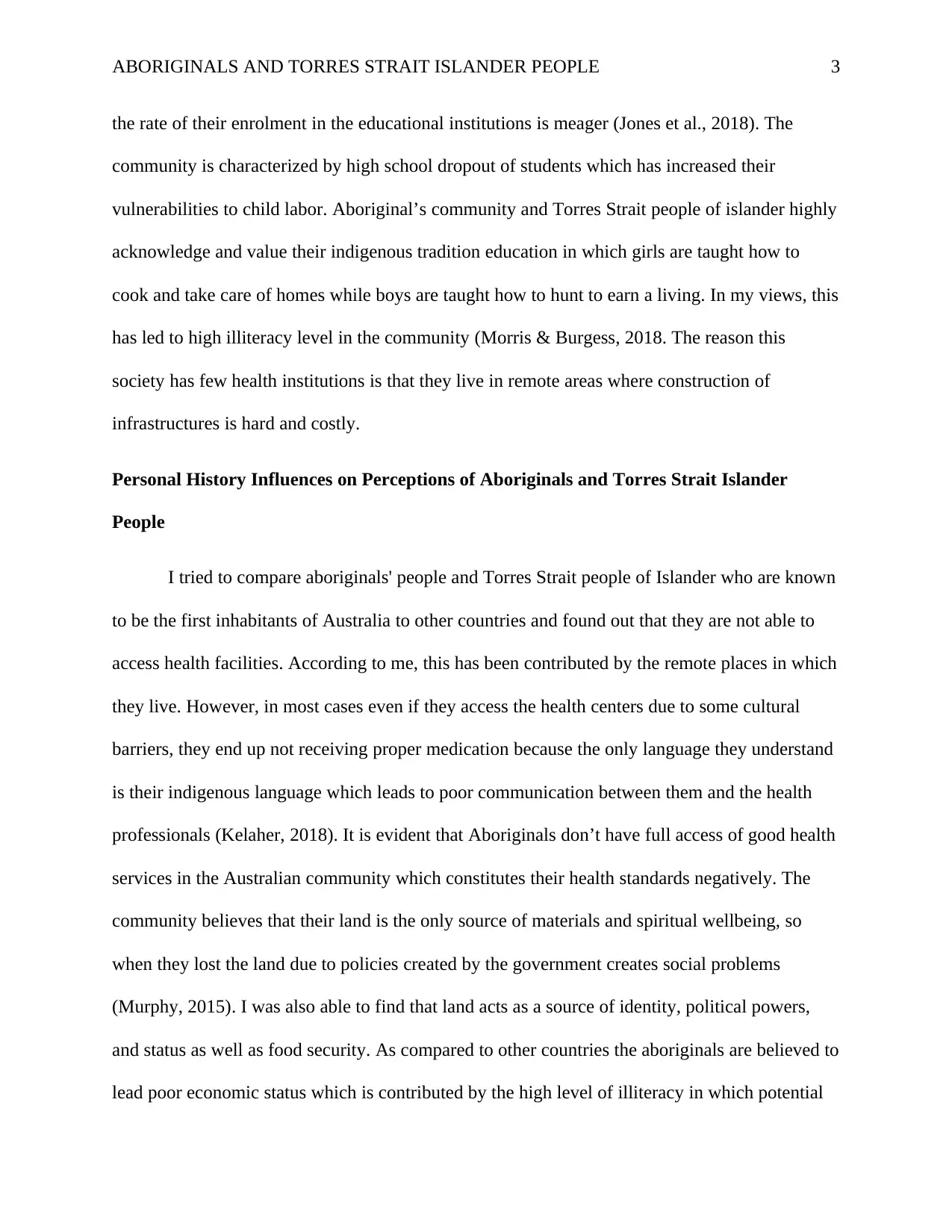
ABORIGINALS AND TORRES STRAIT ISLANDER PEOPLE 3
the rate of their enrolment in the educational institutions is meager (Jones et al., 2018). The
community is characterized by high school dropout of students which has increased their
vulnerabilities to child labor. Aboriginal’s community and Torres Strait people of islander highly
acknowledge and value their indigenous tradition education in which girls are taught how to
cook and take care of homes while boys are taught how to hunt to earn a living. In my views, this
has led to high illiteracy level in the community (Morris & Burgess, 2018. The reason this
society has few health institutions is that they live in remote areas where construction of
infrastructures is hard and costly.
Personal History Influences on Perceptions of Aboriginals and Torres Strait Islander
People
I tried to compare aboriginals' people and Torres Strait people of Islander who are known
to be the first inhabitants of Australia to other countries and found out that they are not able to
access health facilities. According to me, this has been contributed by the remote places in which
they live. However, in most cases even if they access the health centers due to some cultural
barriers, they end up not receiving proper medication because the only language they understand
is their indigenous language which leads to poor communication between them and the health
professionals (Kelaher, 2018). It is evident that Aboriginals don’t have full access of good health
services in the Australian community which constitutes their health standards negatively. The
community believes that their land is the only source of materials and spiritual wellbeing, so
when they lost the land due to policies created by the government creates social problems
(Murphy, 2015). I was also able to find that land acts as a source of identity, political powers,
and status as well as food security. As compared to other countries the aboriginals are believed to
lead poor economic status which is contributed by the high level of illiteracy in which potential
the rate of their enrolment in the educational institutions is meager (Jones et al., 2018). The
community is characterized by high school dropout of students which has increased their
vulnerabilities to child labor. Aboriginal’s community and Torres Strait people of islander highly
acknowledge and value their indigenous tradition education in which girls are taught how to
cook and take care of homes while boys are taught how to hunt to earn a living. In my views, this
has led to high illiteracy level in the community (Morris & Burgess, 2018. The reason this
society has few health institutions is that they live in remote areas where construction of
infrastructures is hard and costly.
Personal History Influences on Perceptions of Aboriginals and Torres Strait Islander
People
I tried to compare aboriginals' people and Torres Strait people of Islander who are known
to be the first inhabitants of Australia to other countries and found out that they are not able to
access health facilities. According to me, this has been contributed by the remote places in which
they live. However, in most cases even if they access the health centers due to some cultural
barriers, they end up not receiving proper medication because the only language they understand
is their indigenous language which leads to poor communication between them and the health
professionals (Kelaher, 2018). It is evident that Aboriginals don’t have full access of good health
services in the Australian community which constitutes their health standards negatively. The
community believes that their land is the only source of materials and spiritual wellbeing, so
when they lost the land due to policies created by the government creates social problems
(Murphy, 2015). I was also able to find that land acts as a source of identity, political powers,
and status as well as food security. As compared to other countries the aboriginals are believed to
lead poor economic status which is contributed by the high level of illiteracy in which potential
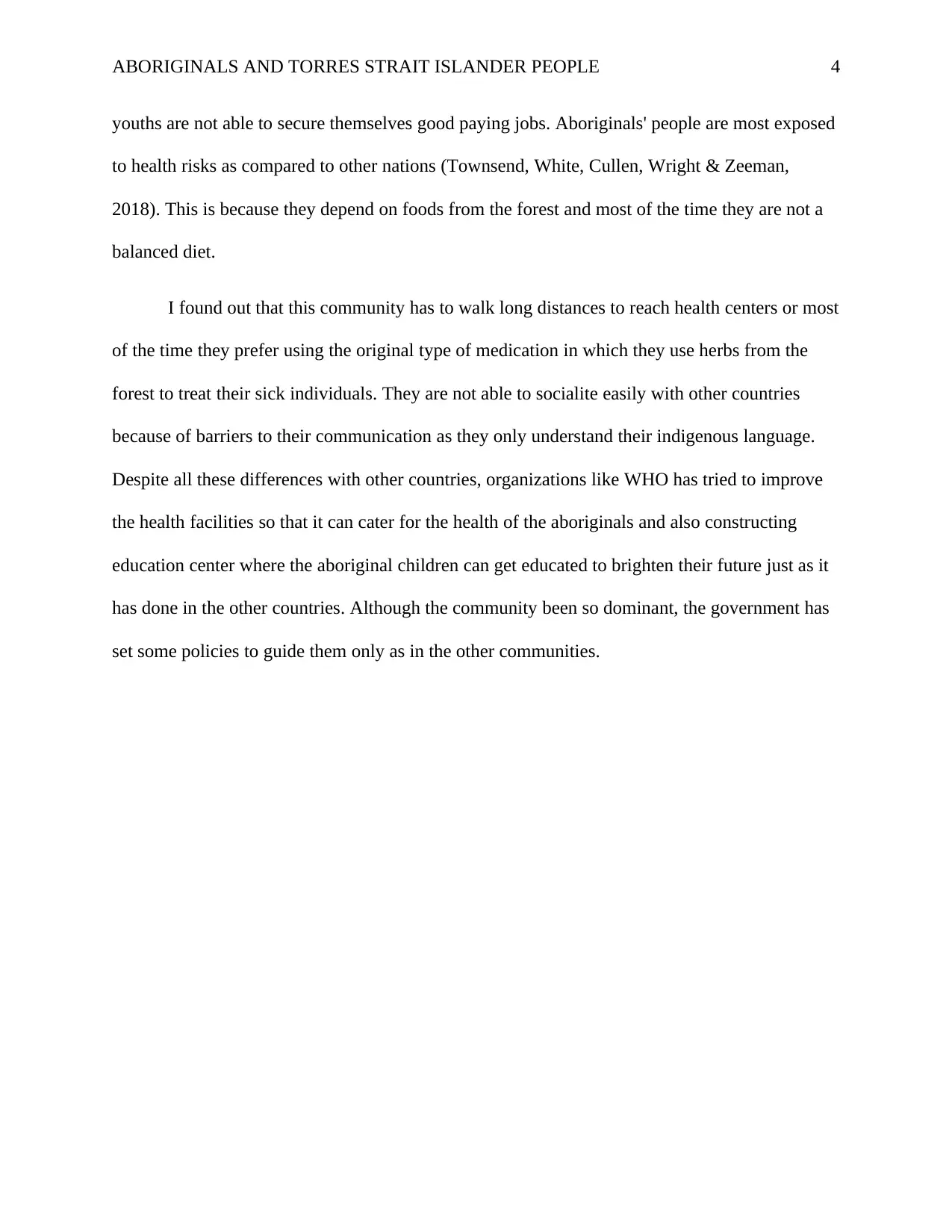
ABORIGINALS AND TORRES STRAIT ISLANDER PEOPLE 4
youths are not able to secure themselves good paying jobs. Aboriginals' people are most exposed
to health risks as compared to other nations (Townsend, White, Cullen, Wright & Zeeman,
2018). This is because they depend on foods from the forest and most of the time they are not a
balanced diet.
I found out that this community has to walk long distances to reach health centers or most
of the time they prefer using the original type of medication in which they use herbs from the
forest to treat their sick individuals. They are not able to socialite easily with other countries
because of barriers to their communication as they only understand their indigenous language.
Despite all these differences with other countries, organizations like WHO has tried to improve
the health facilities so that it can cater for the health of the aboriginals and also constructing
education center where the aboriginal children can get educated to brighten their future just as it
has done in the other countries. Although the community been so dominant, the government has
set some policies to guide them only as in the other communities.
youths are not able to secure themselves good paying jobs. Aboriginals' people are most exposed
to health risks as compared to other nations (Townsend, White, Cullen, Wright & Zeeman,
2018). This is because they depend on foods from the forest and most of the time they are not a
balanced diet.
I found out that this community has to walk long distances to reach health centers or most
of the time they prefer using the original type of medication in which they use herbs from the
forest to treat their sick individuals. They are not able to socialite easily with other countries
because of barriers to their communication as they only understand their indigenous language.
Despite all these differences with other countries, organizations like WHO has tried to improve
the health facilities so that it can cater for the health of the aboriginals and also constructing
education center where the aboriginal children can get educated to brighten their future just as it
has done in the other countries. Although the community been so dominant, the government has
set some policies to guide them only as in the other communities.
Secure Best Marks with AI Grader
Need help grading? Try our AI Grader for instant feedback on your assignments.
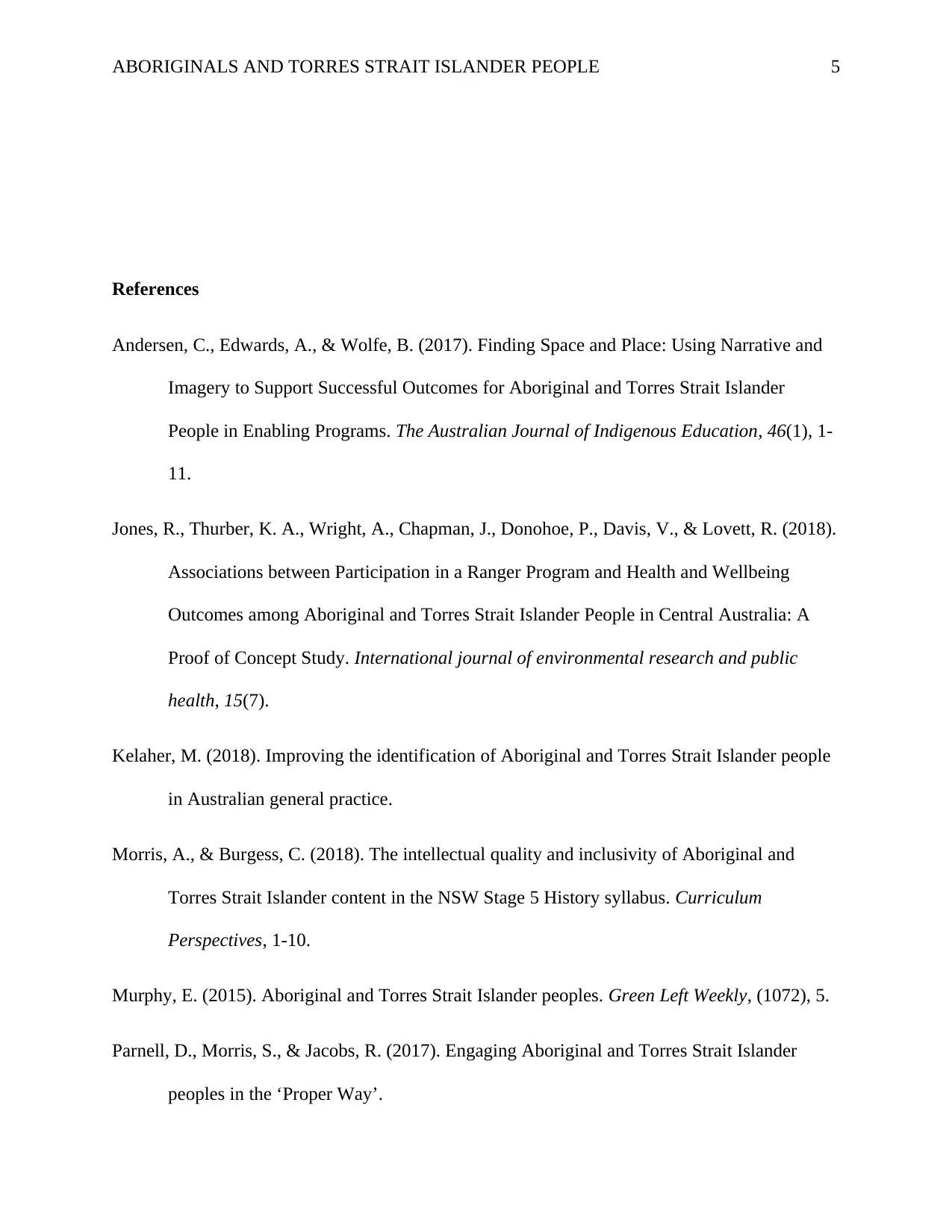
ABORIGINALS AND TORRES STRAIT ISLANDER PEOPLE 5
References
Andersen, C., Edwards, A., & Wolfe, B. (2017). Finding Space and Place: Using Narrative and
Imagery to Support Successful Outcomes for Aboriginal and Torres Strait Islander
People in Enabling Programs. The Australian Journal of Indigenous Education, 46(1), 1-
11.
Jones, R., Thurber, K. A., Wright, A., Chapman, J., Donohoe, P., Davis, V., & Lovett, R. (2018).
Associations between Participation in a Ranger Program and Health and Wellbeing
Outcomes among Aboriginal and Torres Strait Islander People in Central Australia: A
Proof of Concept Study. International journal of environmental research and public
health, 15(7).
Kelaher, M. (2018). Improving the identification of Aboriginal and Torres Strait Islander people
in Australian general practice.
Morris, A., & Burgess, C. (2018). The intellectual quality and inclusivity of Aboriginal and
Torres Strait Islander content in the NSW Stage 5 History syllabus. Curriculum
Perspectives, 1-10.
Murphy, E. (2015). Aboriginal and Torres Strait Islander peoples. Green Left Weekly, (1072), 5.
Parnell, D., Morris, S., & Jacobs, R. (2017). Engaging Aboriginal and Torres Strait Islander
peoples in the ‘Proper Way’.
References
Andersen, C., Edwards, A., & Wolfe, B. (2017). Finding Space and Place: Using Narrative and
Imagery to Support Successful Outcomes for Aboriginal and Torres Strait Islander
People in Enabling Programs. The Australian Journal of Indigenous Education, 46(1), 1-
11.
Jones, R., Thurber, K. A., Wright, A., Chapman, J., Donohoe, P., Davis, V., & Lovett, R. (2018).
Associations between Participation in a Ranger Program and Health and Wellbeing
Outcomes among Aboriginal and Torres Strait Islander People in Central Australia: A
Proof of Concept Study. International journal of environmental research and public
health, 15(7).
Kelaher, M. (2018). Improving the identification of Aboriginal and Torres Strait Islander people
in Australian general practice.
Morris, A., & Burgess, C. (2018). The intellectual quality and inclusivity of Aboriginal and
Torres Strait Islander content in the NSW Stage 5 History syllabus. Curriculum
Perspectives, 1-10.
Murphy, E. (2015). Aboriginal and Torres Strait Islander peoples. Green Left Weekly, (1072), 5.
Parnell, D., Morris, S., & Jacobs, R. (2017). Engaging Aboriginal and Torres Strait Islander
peoples in the ‘Proper Way’.
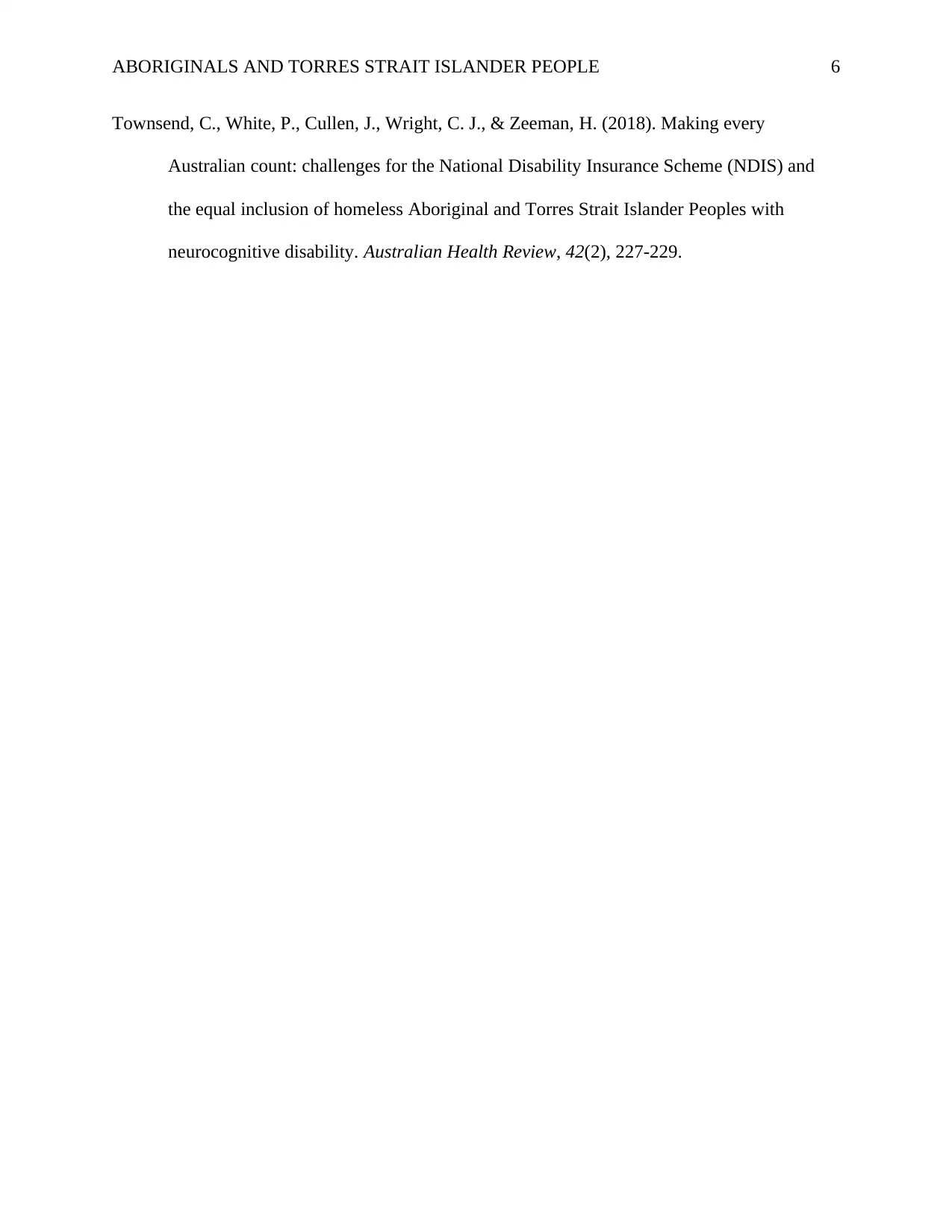
ABORIGINALS AND TORRES STRAIT ISLANDER PEOPLE 6
Townsend, C., White, P., Cullen, J., Wright, C. J., & Zeeman, H. (2018). Making every
Australian count: challenges for the National Disability Insurance Scheme (NDIS) and
the equal inclusion of homeless Aboriginal and Torres Strait Islander Peoples with
neurocognitive disability. Australian Health Review, 42(2), 227-229.
Townsend, C., White, P., Cullen, J., Wright, C. J., & Zeeman, H. (2018). Making every
Australian count: challenges for the National Disability Insurance Scheme (NDIS) and
the equal inclusion of homeless Aboriginal and Torres Strait Islander Peoples with
neurocognitive disability. Australian Health Review, 42(2), 227-229.
1 out of 6
Related Documents
Your All-in-One AI-Powered Toolkit for Academic Success.
+13062052269
info@desklib.com
Available 24*7 on WhatsApp / Email
![[object Object]](/_next/static/media/star-bottom.7253800d.svg)
Unlock your academic potential
© 2024 | Zucol Services PVT LTD | All rights reserved.





